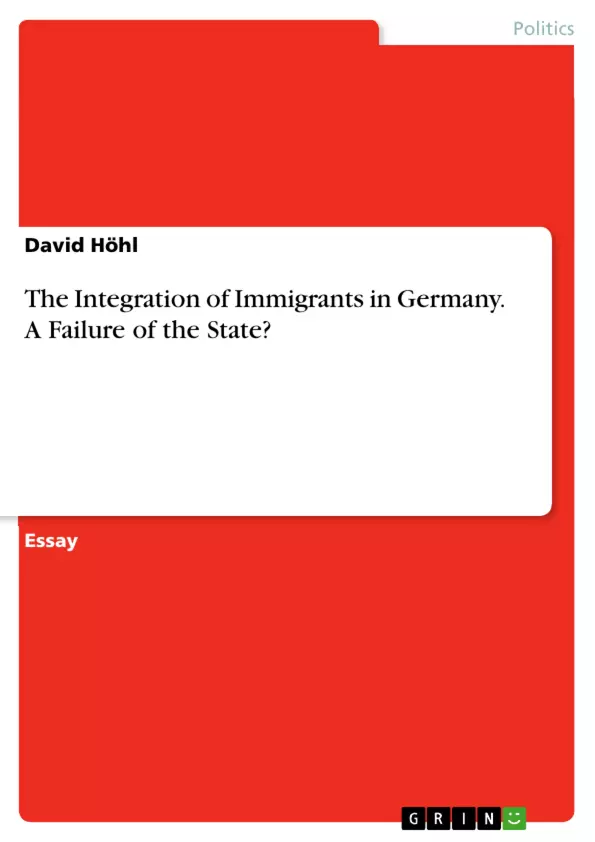How is Germany handling the large number of immigrants in terms of integration? What are strengths and weaknesses of the German integration system? What must be improved? Did the state fail? The thesis statement of this essay is that the integration system of Germany is rather a failure than a success story.
First, the Race Relation Cycles by Park will be explained. Afterwards, the current integration system in Germany will be critically analysed followed by an outline of its consequences. Next, the status quo of Germany’s integration system will be evaluated. Finally, the author will state his advice for policy makers.
Migration and integration are challenges which are posed to national states through globalisation. While these aren’t new international phenomena, their extent is new. 2017’s refugee population globally was the highest since World War Two. "Wir schaffen das" (we make it) said Chancellor Angela Merkel in 2015, referring to the refugee crisis in Germany. Later, this sentence turned into a provocation since large parts of the German population accused her of denying reality. Immigration and integration are still present topics in German politics.
Inhaltsverzeichnis (Table of Contents)
- Introduction
- Race Relation Cycles
- Analysis of the status quo – How is integration managed?
- Asylum Procedure
- Integration measures
- Consequences of the integration system
- Economy
- Crime
- Political Climate and society
- Evaluation and policy advice
- Conclusion
Zielsetzung und Themenschwerpunkte (Objectives and Key Themes)
This essay aims to critically analyze Germany's integration system for immigrants, particularly focusing on the challenges posed by the influx of refugees in recent years. The essay explores the effectiveness of the system, its strengths and weaknesses, and potential areas for improvement. It assesses whether the state has succeeded or failed in integrating immigrants into German society.
- Integration of immigrants in Germany
- Analysis of the German integration system
- Consequences of the integration system on economy, crime, and political climate
- Evaluation of the integration system's success or failure
- Policy recommendations for improving the integration system
Zusammenfassung der Kapitel (Chapter Summaries)
- Introduction: This chapter introduces the topic of migration and integration as challenges faced by national states due to globalization, highlighting the significant increase in refugee populations globally, particularly in Germany. It also sets the context for the essay by outlining the German government's approach to integration and its perceived effectiveness.
- Race Relation Cycles: This chapter is expected to discuss the concept of Race Relation Cycles by Robert E. Park, providing a theoretical framework for understanding the dynamics of integration and potential challenges. It likely explores how immigrants navigate their social and economic integration within a host society.
- Analysis of the status quo – How is integration managed?: This chapter delves into the current German integration system, examining its different aspects. It likely analyzes the asylum procedure for refugees and explores the various integration measures implemented by the state. This chapter will likely present a detailed overview of the system's structure and processes.
- Consequences of the integration system: This chapter focuses on the impact of the integration system on different aspects of German society. It likely discusses the economic implications, including potential labor market effects and contributions made by immigrants. It will also examine the influence on crime rates and the broader political and social climate in Germany, highlighting any challenges or tensions arising from the integration process.
- Evaluation and policy advice: This chapter offers a critical evaluation of the German integration system, analyzing its effectiveness based on the preceding chapters. It likely weighs the strengths and weaknesses of the system, identifying areas for improvement and suggesting specific policy recommendations. This chapter will likely present the author's overall assessment of the integration system's success or failure and propose ways to address identified shortcomings.
Schlüsselwörter (Keywords)
This essay explores the integration of immigrants in Germany, focusing on the challenges posed by recent refugee influxes. Key themes include the analysis of the German integration system, its strengths and weaknesses, the consequences for the economy, crime rates, and the political climate, and policy recommendations for improvement. The essay utilizes concepts such as Race Relation Cycles and examines the effectiveness of the state's efforts in integrating immigrants into German society, ultimately evaluating whether it has been a success or failure.
- Quote paper
- David Höhl (Author), 2019, The Integration of Immigrants in Germany. A Failure of the State?, Munich, GRIN Verlag, https://www.grin.com/document/465435



